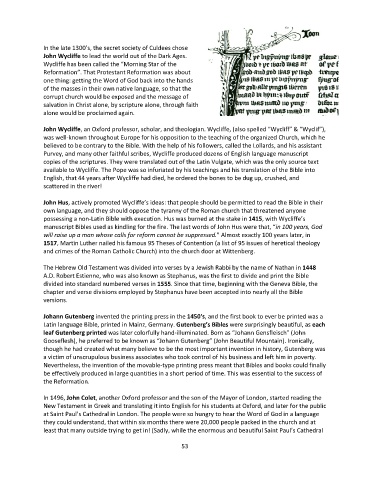Page 54 - Doctrine and History of the Preservation of the Bible Student Textbook
P. 54
In the late 1300’s, the secret society of Culdees chose
John Wycliffe to lead the world out of the Dark Ages.
Wycliffe has been called the “Morning Star of the
Reformation”. That Protestant Reformation was about
one thing: getting the Word of God back into the hands
of the masses in their own native language, so that the
corrupt church would be exposed and the message of
salvation in Christ alone, by scripture alone, through faith
alone would be proclaimed again.
John Wycliffe, an Oxford professor, scholar, and theologian. Wycliffe, (also spelled “Wycliff” & “Wyclif”),
was well-known throughout Europe for his opposition to the teaching of the organized Church, which he
believed to be contrary to the Bible. With the help of his followers, called the Lollards, and his assistant
Purvey, and many other faithful scribes, Wycliffe produced dozens of English language manuscript
copies of the scriptures. They were translated out of the Latin Vulgate, which was the only source text
available to Wycliffe. The Pope was so infuriated by his teachings and his translation of the Bible into
English, that 44 years after Wycliffe had died, he ordered the bones to be dug up, crushed, and
scattered in the river!
John Hus, actively promoted Wycliffe’s ideas: that people should be permitted to read the Bible in their
own language, and they should oppose the tyranny of the Roman church that threatened anyone
possessing a non-Latin Bible with execution. Hus was burned at the stake in 1415, with Wycliffe’s
manuscript Bibles used as kindling for the fire. The last words of John Hus were that, “in 100 years, God
will raise up a man whose calls for reform cannot be suppressed.” Almost exactly 100 years later, in
1517, Martin Luther nailed his famous 95 Theses of Contention (a list of 95 issues of heretical theology
and crimes of the Roman Catholic Church) into the church door at Wittenberg.
The Hebrew Old Testament was divided into verses by a Jewish Rabbi by the name of Nathan in 1448
A.D. Robert Estienne, who was also known as Stephanus, was the first to divide and print the Bible
divided into standard numbered verses in 1555. Since that time, beginning with the Geneva Bible, the
chapter and verse divisions employed by Stephanus have been accepted into nearly all the Bible
versions.
Johann Gutenberg invented the printing press in the 1450's, and the first book to ever be printed was a
Latin language Bible, printed in Mainz, Germany. Gutenberg’s Bibles were surprisingly beautiful, as each
leaf Gutenberg printed was later colorfully hand-illuminated. Born as “Johann Gensfleisch” (John
Gooseflesh), he preferred to be known as “Johann Gutenberg” (John Beautiful Mountain). Ironically,
though he had created what many believe to be the most important invention in history, Gutenberg was
a victim of unscrupulous business associates who took control of his business and left him in poverty.
Nevertheless, the invention of the movable-type printing press meant that Bibles and books could finally
be effectively produced in large quantities in a short period of time. This was essential to the success of
the Reformation.
In 1496, John Colet, another Oxford professor and the son of the Mayor of London, started reading the
New Testament in Greek and translating it into English for his students at Oxford, and later for the public
at Saint Paul’s Cathedral in London. The people were so hungry to hear the Word of God in a language
they could understand, that within six months there were 20,000 people packed in the church and at
least that many outside trying to get in! (Sadly, while the enormous and beautiful Saint Paul’s Cathedral
53

